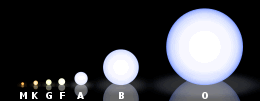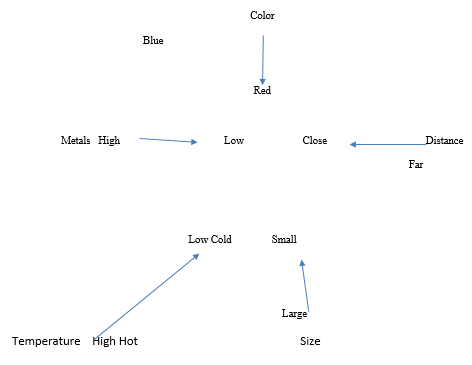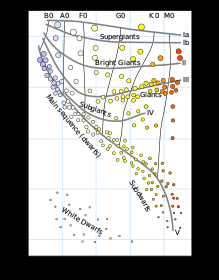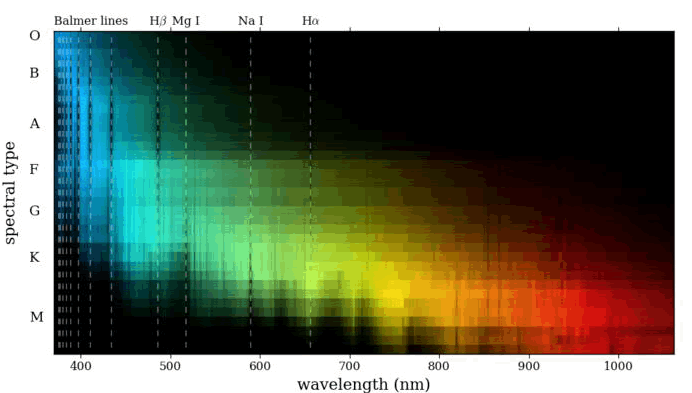Review
, Volume: 10( 2) DOI: 10.37532/2320-6756.2022.10(2).261A New Stellar or Star Classification System-CDMST Color, Distance, Metals Size, Temperature system
- *Correspondence:
- James T. Struck
President Founder of French American Museum of Chicago
President and Founder of Imaginary Heaven University, USA
E-mail: sealsrosesandstars@yahoo.com
Received: January 09, 2022, Manuscript No. M- 51415; Editor assigned: January 12, 2022, PreQC No. P-51415; Reviewed: January 24, 2022, QC No. 51415; Revised: February 8, 2022, Manuscript No. R-51415; Published date: February 28, 2022, DOI: 10.37532/2320–6756.2022.10(2).261
Citation: James T. Struck. A New Stellar or Star Classification System-CDMST Color, Distance, Metals Size, Temperature system. J Phys Astron.2022;10(2):261.
Abstract
A New Stellar or Star Classification System-CDMST where discussed about Color, Distance, Metals Size, Temperature system showing the Red supergiant Antares, blue supergiant Rigel, Sirius A close, UY Scuti large diameter, Icarus 9 billion light years away, Canopus white, Spica massive, Aldebaran red giant, Eta carina blue. Each star is assigned a spectral class from the older Harvard spectral classification and a luminosity class using Roman numerals as explained below, forming the star's spectral type.
Introduction
I invented stellar classification CDMST Color, Distance, Metals Size, Temperature system showing Red supergiant Antares, blue supergiant Rigel, Sirius A close, UY Scuti large diameter, Icarus 9 billion light years away, Canopus white, Spica massive, Aldebaran red giant, Eta carina blue. See on page number 2 how the classification system could work. Star classification or stellar classification systems had been based on the system of Annie Jump Cannon and the Harvard Star classification system.
Modern Classification
The modern classification system is known as the Morgan-Keenan (MK) classification. Each star is assigned a spectral class from the older Harvard spectral classification and a luminosity class using Roman numerals as explained below, forming the star's spectral type.
Other modern stellar classification systems, such as the UBV system, are based on color indices-the measured differences in three or more color magnitudes. Those numbers are given labels such as "U-V" or "B-V", which represent the colors passed by two standard filters (e.g. Ultraviolet, Blue and Visual) FIG.1 [1,2].
Harvard Spectral Classification
The Harvard system is a one-dimensional classification scheme by astronomer Annie Jump Cannon, who re-ordered and simplified the prior alphabetical system by Draper (see next paragraph). Stars are grouped according to their spectral characteristics by single letters of the alphabet, optionally with numeric subdivisions. Main-sequence stars vary in surface temperature from approximately 2,000 K to 50,000 K, whereas more-evolved stars can have temperatures above 100,000 K. Physically, the classes indicate the temperature of the star's atmosphere and are normally listed from hottest to coldest FIG.2 and FIG.3 [3,4].
Figure 2: Color, Distance, Metals, Size, Temperature System CDMST System Invented by (James T. Struck BA, BS, AA, MLIS).
Figure 3: The Hertzsprung-Russell diagram relates stellar classification with absolute magnitude, luminosity, and surface temperature.
The spectral classes O through M, as well as other more specialized classes discussed later, are subdivided by Arabic numerals (0-9), where 0 denotes the hottest stars of a given class. For example, A0 denotes the hottest stars in class A and A9 denotes the coolest ones. Fractional numbers are allowed; for example, the star Mu Normae is classified as O9.7 [5]. The Sun is classified as G2 [10].
Conventional color descriptions are traditional in astronomy, and represent colors relative to the mean color of an A class star, which is considered to be white. The apparent color [9] descriptions are what the observer would see if trying to describe the stars under a dark sky without aid to the eye, or with binoculars. However, most stars in the sky, except the brightest ones, appear white or bluish white to the unaided eye because they are too dim for color vision to work. Red supergiants are cooler and redder than dwarfs of the same spectral type, and stars with particular spectral features such as carbon stars may be far redder than any black body.
The fact that the Harvard classification of a star indicated its surface or photospheric temperature (or more precisely, its effective temperature) was not fully understood until after its development, though by the time the first Hertzsprung-Russell diagram was formulated (by 1914), this was generally suspected to be true [11]. In the 1920s, the Indian physicist Meghnad Saha derived a theory of ionization by extending well-known ideas in physical chemistry pertaining to the dissociation of molecules to the ionization of atoms. First he applied it to the solar chromosphere, then to stellar spectra [12].
Harvard astronomer Cecilia Payne then demonstrated that the O-B-A-F-G-K-M spectral sequence is actually a sequence in temperature [13]. Because the classification sequence predates our understanding that it is a temperature sequence, the placement of a spectrum into a given subtype, such as B3 or A7, depends upon (largely subjective) estimates of the strengths of absorption features in stellar spectra. As a result, these subtypes are not evenly divided into any sort of mathematically representable intervals [14].
Yerkes Spectral Classification
The Yerkes spectral classification, also called the MKK system from the authors' initials, is a system of stellar spectral classification introduced in 1943 by William Wilson Morgan, Philip C. Keenan, and Edith Kellman from Yerkes Observatory [15]. This two-dimensional (temperature and luminosity) classification scheme is based on spectral lines sensitive to stellar temperature and surface gravity, which is related to luminosity (whilst the Harvard classification is based on just surface temperature). Later, in 1953, after some revisions of list of standard stars and classification criteria, the scheme was named the Morgan-Keenan classification, or MK, [16] and this system remains in use FIG.4 [17].
Denser stars with higher surface gravity exhibit greater pressure broadening of spectral lines. The gravity, and hence the pressure, on the surface of a giant star is much lower than for a dwarf star because the radius of the giant is much greater than a dwarf of similar mass. Therefore, differences in the spectrum can be interpreted as luminosity effects and a luminosity class can be assigned purely from examination of the spectrum [18].
A number of different luminosity classes are distinguished, as listed in the TABLE.1 below [19,25].
| Yerkes luminosity classes | ||
|---|---|---|
| Luminosity class | Description | Examples |
| 0orIa+ | hypergiantsor extremely luminous supergiants | Cygnus OB2#12-B3-4Ia+ |
| Ia | luminoussupergiants | Eta Canis Majoris-B5Ia |
| Iab | intermediate-size luminoussupergiants | Gamma Cygni-F8Iab |
| Ib | less luminoussupergiants | Zeta Persei-B1Ib |
| II | bright giants | Beta Leporis-G0II |
| III | normalgiants | Arcturus-K0III |
| IV | subgiants | Gamma Cassiopeiae-B0.5IVpe |
| V | main-sequence stars(dwarfs) | Achernar-B6Vep |
| sd (prefix)orVI | subdwarfs | HD 149382-sdB5orB5VI |
| D (prefix)orVII | white dwarfs | Van Maanen 2-DZ8 |
TABLE. 1. A number of different luminosity classes.
Marginal cases are allowed; for example, a star may be either a supergiant or a bright giant, or may be in between the subgiant and main-sequence classifications. In these cases, two special symbols are used:
• A slash (/) means that a star is either one class or the other
• A dash (-) means that the star is in between the two classes
For example, a star classified as A3-4III/IV would be in between spectral types A3 and A4, while being either a giant star or a subgiant [27].
Sub-dwarf classes have also been used: VI for sub-dwarfs (stars slightly less luminous than the main sequence).
Nominal luminosity class VII (and sometimes higher numerals) is now rarely used for white dwarf or "hot sub-dwarf" classes, since the temperature-letters of the main sequence and giant stars no longer apply to white dwarfs. Occasionally, letters a and b are applied to luminosity classes other than supergiants; for example, a giant star slightly less luminous than typical may be given a luminosity class of III b, while a luminosity class IIIa indicates a star slightly brighter than a typical giant [28].
A sample of extreme V stars with strong absorption in He II λ4686 spectral lines have been given the Vz designation. An example star is HD 93129 B [29].
Spectral Peculiarities
Additional nomenclature, in the form of lower-case letters, can follow the spectral type to indicate peculiar features of the spectrum [30]. For example, 59 Cygni is listed as spectral type B1.5Vnne, indicating a spectrum with the general classification B1.5V, as well as very broad absorption lines and certain emission lines [31-34].
Adding a new system where we consider metals, star size, color, temperature and distance would be a welcome addition to how we can look at stars.
Discussion
Our current Star Classification system is currently linked to memory tool and pneumonic device of “Oh Be A Fine Girl Kiss Me” linked to asking to be kissed, so Color, Distance, Metals, Size, Temperature Classification System describing how many metals a star has, what a stars size is or what the color of the star is I invented is a better system.
Here is a discussion of current systems cited from wikipeida.org’s article on Stellar classification on 1/10/2021.
Conclusion
Color, distance, quantity of metals, distance, temperature and size are 6 new stellar classification systems as they are not tied to Harvard and witch Hunt problems. Page. 2 is an illustration of how the classification of star system works. The Harvard Classification system is linked to a problematic pneumonic device, so a color, metal, size, temperature, distance system would help diversify solar physics and stellar classification.
References
- Habets GMH, Heinze JRW. Empirical bolometric corrections for the main-sequence. Astron Astrophys Suppl Ser. 1981;46:193-237.
[Google Scholar] - Weidner Carsten, Vink Jorick S. The masses, and the mass discrepancy of O-type stars. Astron Astrophys. 2010;524:98.
[Google Scholar] [Crossref] - Charity Mitchell. What color are the stars? 2006.
- The Colour of Stars. Aust Telesc Natl Facil. 2018.
- Moore Patrick. The Guinness Book of Astronomy: Facts and Feats (4th ed). Guinness. 1992.
- The Colour of Stars. Australia Telescope Outreach and Education. 21 December 2004. Retrieved 26 September 2007. Explains the reason for the difference in color perception.
- Baraffe I, Chabrier G, Barman TS, et al. Evolutionary models for cool brown dwarfs and extrasolar giant planets. The case of HD 209458. Astron Astrophys. 2003;402:701-712.
[Google Scholar] [Crossref] - Ledrew Glenn. The Real Starry Sky. J R Astron Soc Can. 2001;95:32.
[Google Scholar] - Sota A, Maíz Apellániz J, Morrell NI, et al. The Galactic O-Star Spectroscopic Survey (GOSSS) II. Bright Southern Stars. Astrophys J Suppl Ser. 2014;211:10.
[Google Scholar] [Crossref] - Phillips Kenneth JH. Guide to the Sun. Cambridge University Press. 1995;47-53.
- Russell, Henry Norris. Relations Between the Spectra and Other Characteristics of the Stars. Popular Astronomy. 1914;22:275-294.
- Saha MN. On a Physical Theory of Stellar Spectra. Proc R Soc Lond A. 1921;99:135-153.
[Google Scholar] [Crossref] - Payne, Cecilia Helena. Stellar Atmospheres; A Contribution to the observational study of high temperature in the reversing layers of stars. 1925.
[Google Scholar] - Pickles AJ. A Stellar Spectral Flux Library: 1150-25000. A Publ Astron Soc Pac. 1998;110:863-878.
[Google Scholar] [Crossref] - Morgan William Wilson, Keenan Philip Childs, Kellman Edith. An atlas of stellar spectra, with an outline of spectral classification. 1943.
[Google Scholar] [Crossref] - Morgan William Wilson, Keenan Philip Childs. Spectral Classification. Annu Rev Astron Astrophys. 1973;11:29-50.
- A note on the spectral atlas and spectral classification. Strasbg Astron Data Cent. Retrieved. 2015.
- Caballero-Nieves SM, Nelan EP, Gies DR, et al. A High Angular Resolution Survey of Massive Stars in Cygnus OB2: Results from the Hubble Space Telescope Fine Guidance Sensors. Astronomical J. 2014;147:40.
[Google Scholar] [Crossref] - Prinja RK, Massa DL. Signature of wide-spread clumping in B supergiant winds. Astron Astrophys. 2010;521:55.
[Google Scholar] [Crossref] - Gray David F. Photospheric Variations of the Supergiant γ Cyg. Astronomical J. 2010;140:1329-1336.
- Nazé Y. Hot stars observed by XMM-Newton. The catalog and the properties of OB stars. Astron Astrophys. 2009;506:1055-1064.
[Google Scholar] [Crossref] - Lyubimkov Leonid S, Lambert David L, Rostopchin, Sergey I, et al. Accurate fundamental parameters for A-, F- and G-type Supergiants in the solar neighbourhood. Mon Not R Astron Soc. 2010;402:1369-1379.
[Google Scholar] [Crossref] - Gray RO, Corbally CJ, Garrison RF, et al. Contributions to the Nearby Stars (NStars) Project: Spectroscopy of Stars Earlier than M0 within 40 Parsecs: The Northern Sample. I. Astronomical J. 2003;126:2048-2059.
[Google Scholar] - Shenavrin VI, Taranova OG, Nadzhip AE. Search for and study of hot circumstellar dust envelopes. Astron. Rep. 2011;55:31-81.
[Google Scholar] - Cenarro AJ, Peletier RF, Sanchez Blazquez P, et al. Medium-resolution Isaac Newton Telescope library of empirical spectra II. The stellar atmospheric parameters. Mon Not R Astron Soc. 2007;374:664-690.
[Google Scholar] [Crossref] - Sion Edward M, Holberg JB, Oswalt Terry D, et al. The White Dwarfs Within 20 Parsecs of the Sun: Kinematics and Statistics. Astronomical J. 2009;138:1681-1689.
[Google Scholar] [Crossref] - DS Hayes, LE Pasinetti, AG Davis Philip. Calibration of Fundamental Stellar Quantities: Proceedings of the 111th Symposium of the International Astronomical Union held at Villa Olmo. Springer Sci Bus Media. 2012;129-130.
[Google Scholar] - Arias Julia I. Spectral Classification and Properties of the O Vz Stars in the Galactic O Star Spectroscopic Survey (GOSSS). Astronomical J. 2016;152:31.
[Google Scholar] [Crossref] - MacRobert Alan. The Spectral Types of Stars. Sky and Telescope. 2006.
- Allen JS. "The Classification of Stellar Spectra". UCL Department of Physics and Astronomy: Astrophysics Group. Retrieved. 2014.
[Google Scholar] - Maíz Apellániz J, Walborn Nolan R, Morrell NI, et al. Pismis 24-1: The Stellar Upper Mass Limit Preserved. Astrophys J. 2007;660:1480-1485.
[Google Scholar] [Crossref] - Fariña Cecilia Bosch, Guillermo L Morrell, Nidia I Barbá, et al. Spectroscopic Study of the N159/N160 Complex in the Large Magellanic Cloud. Astronomical J. 2009;138:510-516.
[Google Scholar] [Crossref] - Rauw G, Manfroid J, Gosset E, et al. Early-type stars in the core of the young open cluster Westerlund 2. Astron Astrophys. 2007;463(3):981-991.
[Google Scholar] [Crossref] - Crowther Paul A. Physical Properties of Wolf-Rayet Stars. Annu Rev Astron Astrophys. 2007;45:177-219.
[Google Scholar] [Crossref]





